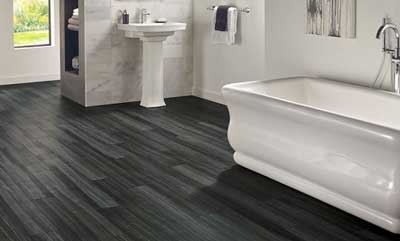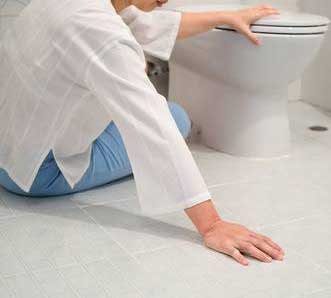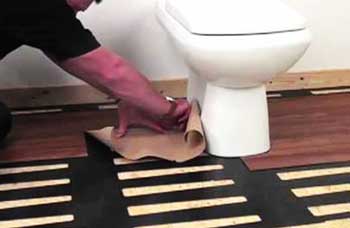Beauty, durability, slip-resistance, cost, and maintenance; these five qualities cover almost what every user will need for bathroom flooring. Finding the right flooring that can accommodate all these can be pretty difficult.

While Vinyl plank floorings are increasingly popular as flooring options lately, you may wonder if they would be suitable in the bathroom. This article, Vinyl plank flooring in the bathroom, specifically deals with this.
Is Vinyl Plank Flooring Good for a Bathroom?
Most floorings are either too cold on the feet, slippery, expensive, or rot quickly. Vinyl plank floorings accommodate many of the other floorings’ lapses and can conveniently serve as a perfect flooring option even in the bathroom. Let’s see some reasons why it stands out.
Pros of the Best Vinyl Flooring for the Bathroom
According to Cost
Waterproof vinyl planks floorings are very affordable for bathrooms compared to other flooring options like ceramic tiles which are more expensive. The average cost of ceramic tiles is about $150 and above. You can also get vinyl planks for as low as $2 and more costly durable planks from $50. Imagine the vast difference.
Durability
Modern vinyl planks are designed to be waterproof and can take in moisture without spoilage or rot. So, they fit perfectly in the bathroom area.
Easy to Maintain
The maintenance routine is super easy. You sweep and mop dry. That’s all it takes, and it lasts for ages. Unlike some other flooring like engineered wood, which fades quickly, and granite floorings that absorb moisture and stain easily, you will require replacement from about 6 to 12 months after installation.
Easy to Install
Dyer’s are at an advantage here because the planks are easy to install. All you need to do is prep the subfloor, get the dimensions right, and layout. Easy, Peasy. And the laminate tools for installation you can easily buy or rent from any tool shop near you.
Slip Protection
One hazard of tile flooring is slipping, especially when wet. Users want to avoid this hazard in the bathroom. Modern vinyl planks floorings offer you unique features like slip protection and damp proof so you can walk safely around the bathroom area.

Unique Appearance
Nowadays, manufacturers make vinyl plank floorings to simulate hardwood, stone, and ceramic tiles, and they look so beautiful. So, if you want to look at stone or hardwood in your bathroom, you can go for vinyl planks without necessarily sacrificing your budget.
Not as Cold as Stone or Granite
In floorings like stone or granite will always have you keep your feet padded because they are cold. You don’t have to worry about this in vinyl planks. This flooring type absorbs heat and stays close to room temperature. So you can walk freely in the bathroom barefooted.
It’s Quiet to Walk On
Tiles and wood make a clicking sound when you walk on them with heeled shoes. The vinyl flooring is quieter.
Cons When Installing Vinyl Plank Floorings in the Bathroom
- It can be difficult to remove, mostly if glued down on the subfloor. Consider using self-adhesive vinyl planks instead.
- Non-biodegradable, so tricky to recycle.
- Topcoat fades out quickly when exposed to sunlight, so it may not be cool for sunlit rooms.
- It can easily puncture and dent if pierced with sharp objects or laid on heavy items, unlike ceramic and stone tiles.
- Though considered beautiful, it does not add to home value because it’s quite cheap.
- Older makes contain asbestos that is dangerous to health.
- Must use a beneficial underlayment on the subfloor
Installing Vinyl Plank Flooring in Bathroom Area
- It can be difficult to remove, mostly if glued down on the subfloor. Consider using self-adhesive vinyl planks instead.
- Non-biodegradable, so tricky to recycle.
- Topcoat fades out quickly when exposed to sunlight, so it may not be cool for sunlit rooms.
- It can easily puncture and dent if pierced with sharp objects or laid on heavy items, unlike ceramic and stone tiles.
- Though considered beautiful, it does not add to home value because it’s quite cheap.
- Older makes contain asbestos that is dangerous to health.
- Must use a beneficial underlayment on the subfloor
Do You have to Remove Toilet to Install Vinyl in the Lavatory?
Not necessarily; it depends on you or the professional installer. You can decide to install around a toilet seat, temporarily remove the toilet seat, layout the plank by cutting in the right shape, and replace it. This is how most professionals do it. Because it is easier to clean, there won’t be a gap in the flooring for the old toilet base, plus it gives a better finish.

Installing Vinyl plank Flooring Around a Bathtub
You need to do the installation correctly around the tub and shower with the most splashes and spills. Carefully trim the ends of the plank to about 1/16″ away from the tub, and lay and caulk with silicone or any other good caulk.
What is the Best Vinyl Plank Flooring for a Bathroom?
Get planks that are engineered to be 100% waterproof. You may choose from WPC (wood-plastic composite) or SPC (stone-plastic composite). They are usually made with four layers: the wear layer, printed vinyl layer, waterproof coat, and the attached cork underlayment.
Conclusion
I give vinyl plank floorings an 80% rating as suitable flooring for bathrooms.
